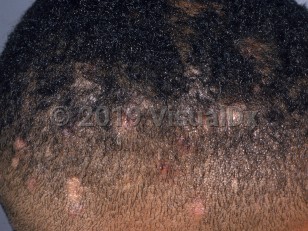Tinea capitis in Infant/Neonate
See also in: Hair and ScalpAlerts and Notices
Important News & Links
Synopsis

Tinea capitis (scalp ringworm) is a fungal infection of the scalp caused by different species of dermatophytes. Most cases occur between the ages of 3 and 7 years, although it has been reported in infants and older children as well. In the United States and Great Britain, the most common causative agent is Trichophyton tonsurans. The most common agent worldwide, however, is Microsporum canis.
It presents as numerous scaly macules and patches of broken hairs and alopecia on the scalp. Some forms are predominantly scaly with little alopecia and may resemble seborrheic dermatitis. More severe forms are associated with inflammatory papules, pustules, and plaques as well as systemic symptoms (ie, fever and malaise).
Majocchi-like granulomas, deep ulcerated fungal infections, severe tinea capitis and corporis, and fungal nail involvement are characteristic of an inherited deficiency of CARD9 (caspase recruitment domain-containing protein 9), an inflammatory cascade-associated protein. The disorder is autosomal recessive and is most common in North Africa countries including Algeria, Morocco, and Tunisia. The infections usually begin in childhood and are caused by Trichophyton rubrum and Trichophyton violaceum. Lymphadenopathy, high IgE antibody levels, and eosinophilia are common, and the disorder can be fatal.
It presents as numerous scaly macules and patches of broken hairs and alopecia on the scalp. Some forms are predominantly scaly with little alopecia and may resemble seborrheic dermatitis. More severe forms are associated with inflammatory papules, pustules, and plaques as well as systemic symptoms (ie, fever and malaise).
Majocchi-like granulomas, deep ulcerated fungal infections, severe tinea capitis and corporis, and fungal nail involvement are characteristic of an inherited deficiency of CARD9 (caspase recruitment domain-containing protein 9), an inflammatory cascade-associated protein. The disorder is autosomal recessive and is most common in North Africa countries including Algeria, Morocco, and Tunisia. The infections usually begin in childhood and are caused by Trichophyton rubrum and Trichophyton violaceum. Lymphadenopathy, high IgE antibody levels, and eosinophilia are common, and the disorder can be fatal.
Codes
ICD10CM:
B35.0 – Tinea barbae and tinea capitis
SNOMEDCT:
5441008 – Tinea capitis
B35.0 – Tinea barbae and tinea capitis
SNOMEDCT:
5441008 – Tinea capitis
Look For
Subscription Required
Diagnostic Pearls
Subscription Required
Differential Diagnosis & Pitfalls

To perform a comparison, select diagnoses from the classic differential
Subscription Required
Best Tests
Subscription Required
Management Pearls
Subscription Required
Therapy
Subscription Required
References
Subscription Required
Last Reviewed:08/15/2019
Last Updated:08/15/2019
Last Updated:08/15/2019
 Patient Information for Tinea capitis in Infant/Neonate
Patient Information for Tinea capitis in Infant/Neonate
Premium Feature
VisualDx Patient Handouts
Available in the Elite package
- Improve treatment compliance
- Reduce after-hours questions
- Increase patient engagement and satisfaction
- Written in clear, easy-to-understand language. No confusing jargon.
- Available in English and Spanish
- Print out or email directly to your patient
Upgrade Today

Tinea capitis in Infant/Neonate
See also in: Hair and Scalp

